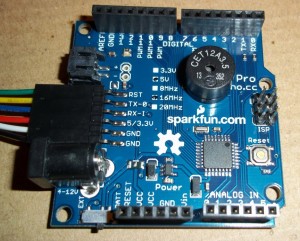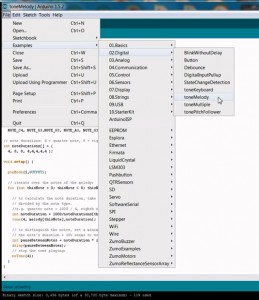I picked up an Arduino Pro from Sparkfun during their cyber monday sale. The Pro is a stripped down version of an Arduino UNO for about half to a third the price. It is missing quite a few features so if you are just starting out a standard Arduino is probably a safer bet. If Arduinos are old hat the price point is pretty attractive, I picked mine up for just under $9 USD.
The Sparkfun Pro has a round footprint in the middle of the board that turns out to be meant for installation of a buzzer, specifically the Sparkfun 12mm Buzzer. This little buzzer drops right onto the board, but other than a comment from Sparkfunion Robert there is no documentation on how to mount or use the buzzer.
It turns out the Buzzer recommended is really a tiny speaker. A mag coil driving a tiny disk. The two pins connected to the mounting holes connect to the Arduino digital pins 4 and 5. It doesn’t seem to matter which direction you mount the buzzer. I happened to mount the buzzer with the words arbitrarily “up”, which resulted in the “+” side of the buzzer “down”. Down being connected to D4 and Up connected to D5.
Driving the buzzer is relatively simple, you just set one of the pins, D4 or D5, to an output, pinMode(4,OUTPUT) or pinMode(5,OUTPUT), and drive the other pin, 4 or 5, with a changing signal. The recommended buzzer is basically a speaker and so the input needs to be modulated to generate a sound.
The simplest code to generate a 1 second, 1 KHz tone is:
void setup()
{
pinMode(5,OUTPUT);
tone(4, 1000, 1000);
}
void loop()
{
}
The built in Arduino example toneMelody can be easily modified to play out the buzzer.
First open the toneMelody example:
Modify the bolded lines and upload the sketch to the Pro:
==========================================================================
#include "pitches.h"
// notes in the melody:
int melody[] = {
NOTE_C4, NOTE_G3,NOTE_G3, NOTE_A3, NOTE_G3,0, NOTE_B3, NOTE_C4};
// note durations: 4 = quarter note, 8 = eighth note, etc.:
int noteDurations[] = {
4, 8, 8, 4,4,4,4,4 };
void setup() {
pinMode(5,OUTPUT); // set the "other" buzzer pin to an output
// iterate over the notes of the melody:
for (int thisNote = 0; thisNote < 8; thisNote++) {
// to calculate the note duration, take one second
// divided by the note type.
//e.g. quarter note = 1000 / 4, eighth note = 1000/8, etc.
int noteDuration = 1000/noteDurations[thisNote];
tone(4, melody[thisNote],noteDuration); // output the tone on the "+" pin
// to distinguish the notes, set a minimum time between them.
// the note's duration + 30% seems to work well:
int pauseBetweenNotes = noteDuration * 1.30;
delay(pauseBetweenNotes);
// stop the tone playing:
noTone(4); // turn off the tone
}
}
void loop() {
// no need to repeat the melody.
}
==========================================================================
The Arduino Pro buzzer playing the toneMelody example sounds like this:

